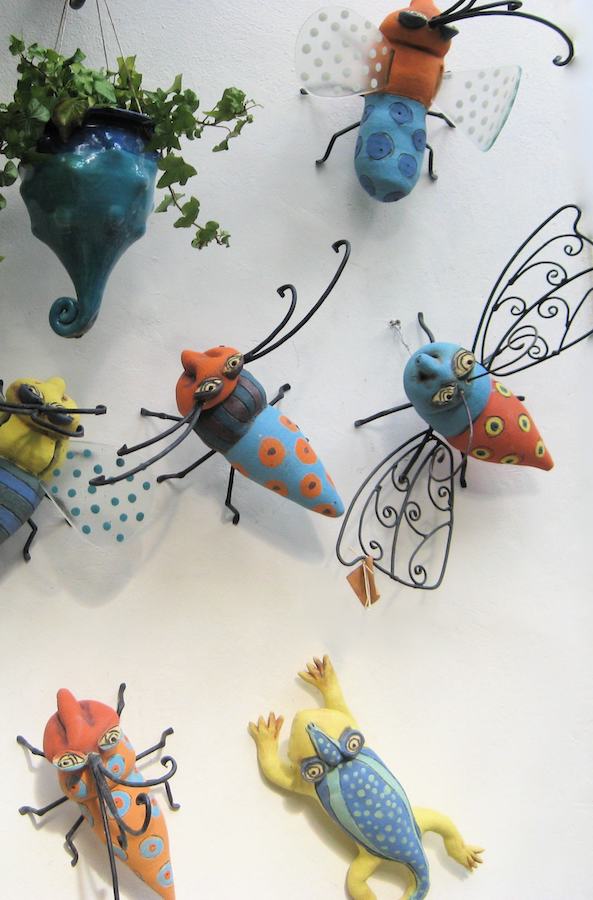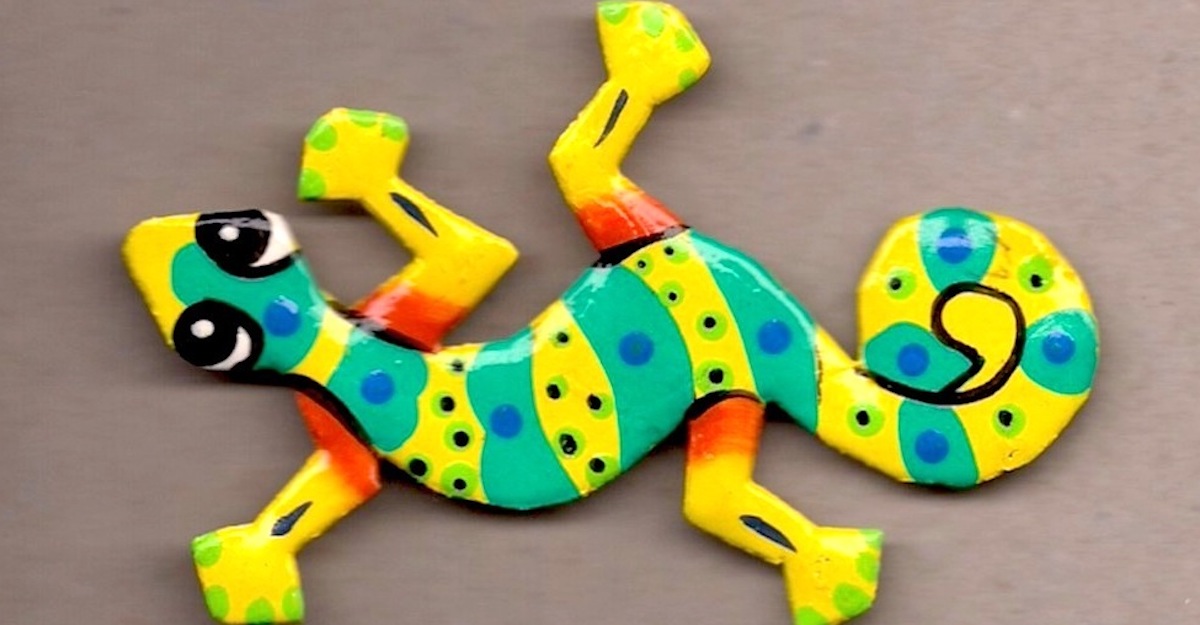Art: Springboard and Motivational Tool
We commonly use art lessons to encourage creativity and to develop a sense of aesthetics. Why not also link art lessons to other subjects so that an art project can become
-
a springboard that encourages curiosity,
-
a motivational tool to learn more about the subject of the art lesson, or
-
an image that becomes the “hook” to hang information on?
While traveling in Hungary a few years ago, we found large clay-and-wire insects decorating a garden wall. These were no ordinary insects. Over-sized, bulging human eyes stared out at passersby. From their heads sprouted four curly antennae. Some were wingless, and some had several wings.
What a good image for an art lesson! These insects are fun to draw—they have such interesting personalities.

But we could also pair the art lesson with a science lesson about insects. By comparing these fanciful insects to real insects, one could reinforce learning the characteristics that define the insect world.
A similar pairing could be made with painted metal art from Haiti. Haitians cut used 50-gallon steel drums into shapes like geckos, dragonflies, and other animals, and paint them with bright, imaginative colors. The finished artwork is inexpensive--and it makes a great foundation for art projects.

But why stop there? If you are drawing a gecko, why not also visit a pet store to begin a study of REAL geckos and lizards? In this way, the art project becomes a motivational spark to encourage curiosity about the creatures.
Sometimes an art lesson can serve to reinforce a concept. If you were studying Mexico, or the southern United States, including the nine-banded armadillo makes a fascinating addition to the lesson. What other animal has
-
a nose like a pig,
-
a shell like a turtle, and
-
bristly hairs that act as sensors?
When frightened, it can jump like a rabbit; to protect itself, it hides in a burrow. It has good-sized eyes, but it is practically blind; rather large ears, but it is quite deaf. To remember all those facts, try DRAWING the armadillo—you will have to give the creature a careful look, a look that will link facts and image unforgettably.

An art lesson can serve to reinforce a concept, but the reverse can also be true: a concept can serve to reinforce an art lesson. An interesting topic for an art lesson is the relationship and tension between an object and its background.
One way to help young artists learn about this tension is to begin by learning about butterflies. Butterflies are often protected by camouflage—their coloring resembles their environment.

Once we learn about camouflage, we could use the information to solve an interesting art problem: we could draw and color a butterfly, and then create a background that camouflages the insect. As students create a background that blends with the butterfly without completely hiding it, students would have deal to with the object-to-background relationships.
Next time you are looking for visual aids for a science lesson, try one of these art lessons!
We commonly use art lessons to encourage creativity and to develop a sense of aesthetics. Why not also link art lessons to other subjects so that an art project can become
-
a springboard that encourages curiosity,
-
a motivational tool to learn more about the subject of the art lesson, or
-
an image that becomes the “hook” to hang information on?
While traveling in Hungary a few years ago, we found large clay-and-wire insects decorating a garden wall. These were no ordinary insects. Over-sized, bulging human eyes stared out at passersby. From their heads sprouted four curly antennae. Some were wingless, and some had several wings.
What a good image for an art lesson! These insects are fun to draw—they have such interesting personalities.

But we could also pair the art lesson with a science lesson about insects. By comparing these fanciful insects to real insects, one could reinforce learning the characteristics that define the insect world.
A similar pairing could be made with painted metal art from Haiti. Haitians cut used 50-gallon steel drums into shapes like geckos, dragonflies, and other animals, and paint them with bright, imaginative colors. The finished artwork is inexpensive--and it makes a great foundation for art projects.

But why stop there? If you are drawing a gecko, why not also visit a pet store to begin a study of REAL geckos and lizards? In this way, the art project becomes a motivational spark to encourage curiosity about the creatures.
Sometimes an art lesson can serve to reinforce a concept. If you were studying Mexico, or the southern United States, including the nine-banded armadillo makes a fascinating addition to the lesson. What other animal has
-
a nose like a pig,
-
a shell like a turtle, and
-
bristly hairs that act as sensors?
When frightened, it can jump like a rabbit; to protect itself, it hides in a burrow. It has good-sized eyes, but it is practically blind; rather large ears, but it is quite deaf. To remember all those facts, try DRAWING the armadillo—you will have to give the creature a careful look, a look that will link facts and image unforgettably.

An art lesson can serve to reinforce a concept, but the reverse can also be true: a concept can serve to reinforce an art lesson. An interesting topic for an art lesson is the relationship and tension between an object and its background.
One way to help young artists learn about this tension is to begin by learning about butterflies. Butterflies are often protected by camouflage—their coloring resembles their environment.

Once we learn about camouflage, we could use the information to solve an interesting art problem: we could draw and color a butterfly, and then create a background that camouflages the insect. As students create a background that blends with the butterfly without completely hiding it, students would have deal to with the object-to-background relationships.
Next time you are looking for visual aids for a science lesson, try one of these art lessons!
We commonly use art lessons to encourage creativity and to develop a sense of aesthetics. Why not also link art lessons to other subjects so that an art project can become
-
a springboard that encourages curiosity,
-
a motivational tool to learn more about the subject of the art lesson, or
-
an image that becomes the “hook” to hang information on?
While traveling in Hungary a few years ago, we found large clay-and-wire insects decorating a garden wall. These were no ordinary insects. Over-sized, bulging human eyes stared out at passersby. From their heads sprouted four curly antennae. Some were wingless, and some had several wings.
What a good image for an art lesson! These insects are fun to draw—they have such interesting personalities.

But we could also pair the art lesson with a science lesson about insects. By comparing these fanciful insects to real insects, one could reinforce learning the characteristics that define the insect world.
A similar pairing could be made with painted metal art from Haiti. Haitians cut used 50-gallon steel drums into shapes like geckos, dragonflies, and other animals, and paint them with bright, imaginative colors. The finished artwork is inexpensive--and it makes a great foundation for art projects.

But why stop there? If you are drawing a gecko, why not also visit a pet store to begin a study of REAL geckos and lizards? In this way, the art project becomes a motivational spark to encourage curiosity about the creatures.
Sometimes an art lesson can serve to reinforce a concept. If you were studying Mexico, or the southern United States, including the nine-banded armadillo makes a fascinating addition to the lesson. What other animal has
-
a nose like a pig,
-
a shell like a turtle, and
-
bristly hairs that act as sensors?
When frightened, it can jump like a rabbit; to protect itself, it hides in a burrow. It has good-sized eyes, but it is practically blind; rather large ears, but it is quite deaf. To remember all those facts, try DRAWING the armadillo—you will have to give the creature a careful look, a look that will link facts and image unforgettably.

An art lesson can serve to reinforce a concept, but the reverse can also be true: a concept can serve to reinforce an art lesson. An interesting topic for an art lesson is the relationship and tension between an object and its background.
One way to help young artists learn about this tension is to begin by learning about butterflies. Butterflies are often protected by camouflage—their coloring resembles their environment.

Once we learn about camouflage, we could use the information to solve an interesting art problem: we could draw and color a butterfly, and then create a background that camouflages the insect. As students create a background that blends with the butterfly without completely hiding it, students would have deal to with the object-to-background relationships.
Next time you are looking for visual aids for a science lesson, try one of these art lessons!



